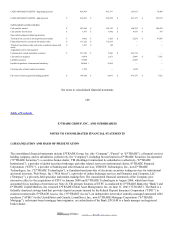eTrade 2001 Annual Report Download - page 121
Download and view the complete annual report
Please find page 121 of the 2001 eTrade annual report below. You can navigate through the pages in the report by either clicking on the pages listed below, or by using the keyword search tool below to find specific information within the annual report.
method. Realized gains and losses and declines in fair value judged to be other than temporary are included in gains on bank loans
held for sale and other securities-net for the Company’ s Banking operations; other amounts are included in non-operating income
(expense). Interest earned is included in interest income for Bank investments or non-operating income for corporate investments.
The Company reviews securities classified as available-for-sale for other than temporary impairment at each balance sheet date. Other
than temporary impairment, if any, is reported in the same manner as a realized loss on investments.
Trading securities and financial derivative instruments that do not qualify for hedge accounting are bought and held principally for the
purpose of selling them in the near term. Securities purchased for trading and financial derivative instruments that do not qualify for
hedge accounting are carried at estimated fair value. Realized and unrealized gains and losses on securities classified as trading are
included in gains on bank loans held for sale and other securities-net and are derived using the specific identification cost method.
Property and Equipment —Property and equipment are carried at cost and are depreciated on a straight-line basis over their estimated
useful lives, generally three to ten years. Leasehold improvements are stated at cost and are amortized over the lesser of their estimated
useful lives or lease terms.
Goodwill and Other Intangibles— Goodwill and other intangibles represent the excess of purchase price over the fair value of net
assets acquired resulting from acquisitions made by the Company. Goodwill is being amortized using the straight-line method based on
an estimated useful life of five to twenty years. Other intangibles are amortized as follows: Specialist books, straight-line over 30
years; customer accounts, double-declining balance over seven years; and other intangibles, straight-line five years. In June 2001, the
Financial Accounting Standards Board (“FASB”) issued SFAS, No. 141, Business Combinations , and SFAS No. 142, Goodwill and
Other Intangible Assets , effective for fiscal years beginning after December 15, 2001. SFAS No.141 requires that all business
combinations initiated after June 30, 2001 be accounted for under the purchase method of accounting and addresses the initial
recognition and measurement of goodwill and intangible assets acquired in the business combination and the accounting for goodwill
and other intangible assets subsequent to their acquisition. SFAS No. 142 provides that intangible assets with finite useful lives be
amortized and that goodwill and intangible assets with indefinite lives not be amortized, but rather be tested at least annually for
impairment. The acquisition of Dempsey occurred subsequent to June 30, 2001, and has been accounted for in
105
Table of Contents
accordance with SFAS Nos. 141 and 142; accordingly, the $143.8 million of goodwill recognized was not amortized during the year
ended December 31, 2001. For all other acquisitions previously accounted for under the purchase method of accounting, the Company
will adopt SFAS No. 142 effective January 1, 2002. Upon adoption of SFAS No. 142, the Company will stop the amortization of
goodwill with an estimated net carrying value of approximately $417.6 million at December 31, 2001 (excludes Dempsey goodwill of
$143.8 million) and annual amortization expense of $27.8million that resulted from business combinations initiated prior to the
adoption of SFAS No.141. Goodwill acquired subsequent to June 30, 2001 is not amortized. The Company is currently evaluating
goodwill under the SFAS No. 142 transitional impairment test and expects to record an impairment charge of approximately $300.0
million to $350.0 million, primarily attributed to the goodwill from its international acquisitions. Transitional impairment loss will be
recognized as the effect of a change in accounting principle in the first quarter of fiscal 2002.
Other Assets —Other assets include real estate acquired through foreclosure and repossessed automobiles. Real estate properties
acquired through foreclosures, commonly referred to as real estate owned (“REO”) and repossessed assets are recorded at fair value
less estimated selling costs at acquisition. Fair value is determined by appraisal or other appropriate valuation method. Losses
estimated at the time of acquisition are charged to the allowance for loan losses. Management performs periodic valuations and
establishes a valuation allowance for REO and repossessed assets through a charge to income if the carrying value of a property
exceeds its estimated fair value less estimated selling costs. The total of REO and repossessed assets was $3.3 million at December 31,
2001 and $0.9million at September 30, 2000.
2002. EDGAR Online, Inc.
























